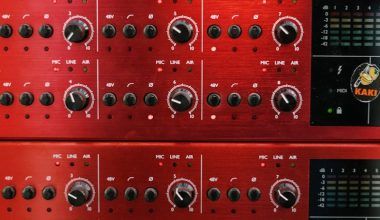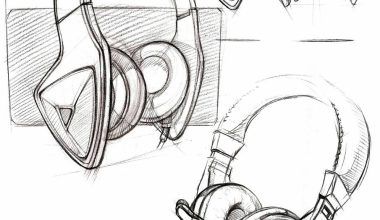Cardioid is a word that sounds fancy, but its meaning is pretty straightforward. Imagine a heart shape. That’s what cardioid looks like. In the world of sound, a cardioid microphone picks up sounds from the front while ignoring most noises from the sides and back.
Let’s say you’re recording a song or doing a podcast. You want to capture your voice, not the fan in the corner or the dog barking outside. This is where a cardioid microphone shines. It focuses on your voice and makes it crystal clear, while unwanted noises stay in the background.
Why is it Called “Cardioid”?
The name cardioid comes from the Greek word “kardia,” which means heart. That’s because the area where this microphone picks up sound forms a heart shape when you map it out. Cool, right? Think of it as a little helper that listens carefully to what’s in front of it and says “no thanks” to other noises.
How Does a Cardioid Microphone Work?
Here’s an easy way to picture it:
- Front and Center: The front of the microphone is the star. It captures your voice or instrument.
- Side Noise? Nope!: The sides of the microphone are less sensitive. This means noises coming from here are barely noticed.
- Behind You? No Chance: Sounds from the back are almost ignored completely.
Inside the microphone, there are clever designs that manage sound waves, so they amplify the sounds you want and reduce the ones you don’t.
Why Do People Love Cardioid Microphones?
Cardioid microphones make life easier for everyone who loves sound. Whether you’re a musician, a YouTuber, or someone in a meeting, they help you sound your best.
Here’s why they’re so popular:
- Clear Sound: Your voice or instrument shines, without distractions from background noise.
- Perfect for Noisy Spaces: Cardioid microphones cut out unwanted chatter or humming.
- Stops Feedback: Ever heard that annoying squeal at a concert? Cardioid microphones are designed to avoid it.
- Easy to Use: Just point the front of the microphone toward the sound source. That’s it!
Everyday Uses of Cardioid Microphones
1. Live Performances
When a singer performs on stage, their voice needs to be heard clearly over the instruments and crowd noise. Cardioid microphones make sure the singer’s voice takes center stage.
2. Recording Studios
In a recording studio, cardioid microphones help isolate the singer’s voice or a particular instrument, giving you a clean and professional sound.
3. Podcasts and Streaming
Podcasters and streamers use cardioid microphones because they focus on their voice and ignore background distractions, like typing sounds or the AC.
4. Office Meetings
Cardioid microphones make sure the speaker’s voice is clear during virtual meetings, even if the surroundings are a bit noisy.
5. Outdoor Recording
When recording outdoors, cardioid microphones reduce wind noise and focus on what’s important, like bird songs or dialogue.
Types of Cardioid Microphones
Cardioid microphones aren’t all the same. Here are the most common types and their uses:
1. Standard Cardioid
These are the most basic and widely used. Great for singers, speakers, and podcasters.
2. Supercardioid
A step up from standard cardioid, these microphones are even better at focusing on sounds directly in front while ignoring more side noise.
3. Hypercardioid
With an even narrower focus, hypercardioid microphones are ideal for very noisy environments.
4. Shotgun Microphones
These are long and skinny microphones often used in film and TV to capture specific sounds from far away.
How to Use a Cardioid Microphone Like a Pro
- Point the Microphone Correctly: Always face the front of the microphone toward the sound source.
- Control Background Noise: Place noisy equipment, like fans or speakers, behind the microphone.
- Use Accessories: For vocals, use a pop filter to reduce harsh sounds. Outdoors, use a windscreen to block wind noise.
- Experiment: Try different placements and angles to find what works best for your setup.
Cardioid vs. Omnidirectional: Which One is Better?
It depends on what you need!
Cardioid
- Best for focusing on a single sound source.
- Blocks out background noise.
- Ideal for live performances, podcasts, and recordings.
Omnidirectional
- Captures sound equally from all directions.
- Perfect for group conversations or ambient sound recordings.
What Makes Cardioid Microphones Special?
The ability to focus on one sound while ignoring others is what makes cardioid microphones stand out. Imagine recording a podcast in your living room. With a cardioid microphone, your voice will sound sharp and professional, while the sound of traffic outside fades away.
Why Musicians Love Cardioid
Musicians love cardioid microphones for their simplicity and effectiveness. When playing live, they ensure the crowd hears only the music and not the background chatter. In studios, they help capture the pure sound of instruments or vocals without interference.
Cardioid in Film and TV
Filmmakers use special cardioid microphones like shotguns to capture dialogue from a distance while ignoring noise from the crew or environment. This makes scenes feel more immersive and professional.
Fun Facts About Cardioid
- The heart-shaped pattern of cardioid microphones makes them easy to recognize.
- Even big-name performers like Ed Sheeran use cardioid microphones for live shows.
- They are available in all shapes and sizes, from tiny clip-on mics to large studio setups.
Conclusion: Why You Need to Know What is Cardioid
Understanding what is cardioid can make a big difference in how you approach sound. These microphones are reliable, easy to use, and versatile, making them the perfect choice for almost any audio situation. Whether you’re recording your first podcast, playing in a band, or shooting a short film, a cardioid microphone can make your work sound professional and polished.
So, the next time someone asks, “What is cardioid?” you can smile and tell them it’s the heart-shaped sound hero that makes all the difference.
Related Articles:
For further reading, explore these related articles:
- Become a Pro Rap Beat Creator: The Ultimate Guide for Beginners
- The Ultimate Guide to WAV Songs Download
For additional resources on music marketing and distribution, visit Deliver My Tune.






